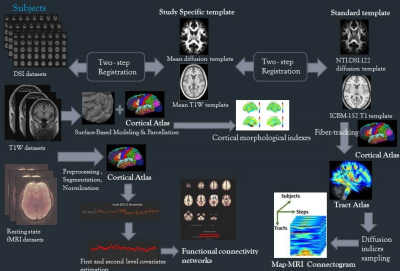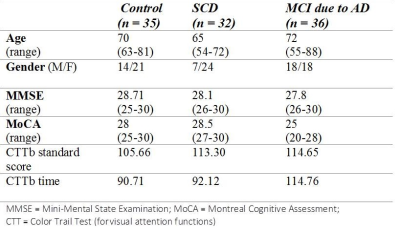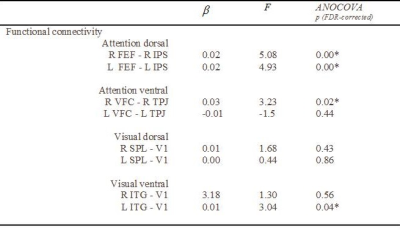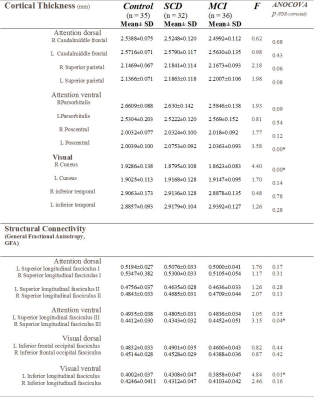0730
Intrinsic Visual Attention Networks and Their Structural Connectivity Reveal Structure-Function Changes of the Visual-Attention System in Subjective Cognitive Decline and Mild Cognitive Impairment1Institute of Medical Device and Imaging, National Taiwan University College of Medicine, Taipei, Taiwan, 2Department of Psychology, National Taiwan University, Taipei, Taiwan, 3Department of Neurology, National Taiwan University Hospital, College of Medicine, National Taiwan University, Taipei, Taiwan, 4Molecular Imaging Center, National Taiwan University, Taipei, Taiwan, 5Graduate Institute of Brain and Mind Sciences, College of Medicine, National Taiwan University, Taipei, Taiwan
Synopsis
In addition to the memory problems, older adults with mild cognitive impairment (MCI) may suffer from visual-attention problems. We speculated that even at the very early stage such as subjective cognitive decline (SCD), visual-attention function may be affected. We investigated the control, SCD and MCI groups’ functional connectivity of the attention and visual networks and the five association fiber tracts responsible for long-range dorsal and ventral pathways. The ventral attention and ventral visual networks exhibit significant group differences in all functional, structural connectivity and cortical thickness. Our findings suggest that in contrast to the top-down goal-directed dorsal attention and the object location of dorsal visual functions, the ventral attention and ventral visual functions for processing unfamiliar stimuli and object recognition may be changed in SCD and MCI. In summary, the visual-attention functions may be affected in SCD and MCI.
Introduction
Division of the dorsal (occipital-parietal) and ventral (occipital-temporal) visual streams is one of the fundamental principles of visual processing. Previous research proposed two anatomically and functionally distinct attention systems with complementary roles in the human brain: the dorsal frontoparietal system mediates the top-down goal-directed attention, and the ventral frontoparietal system detects bottom-up unexpected stimuli and trigger attention shifts1,2. Functional connectivity articles reported that the dorsal and ventral attention networks are distinguishable on the correlation patterns even under task-free state3. In addition to the memory problems, older adults with mild cognitive impairment (MCI) may suffer from visual-attention problems. We speculated that even at the very early stage such as subjective cognitive decline (SCD), visual-attention function may be affected. We considered the visual and attention networks as a whole system responsible for human visual-attention functions. The present study investigated the control, SCD and MCI groups’ functional connectivity of the attention and visual networks and the five association fiber tracts responsible for long-range dorsal and ventral pathways (superior longitudinal fasciculus I, II, III, inferior frontal occipital fasciculus, and inferior longitudinal fasciculus)4,5 (Figure 1).Material & Method
Subjects The participants included 35 cognitively normal older adults (Group1, mean ages 70 yrs), 32 older adults with subjective cognitive decline (SCD) (Group 2, mean age 65 yrs) and 36 older adults with MCI (Group 3, mean age 72 yrs). All participants were diagnosed by memory clinic and completed a battery of neuropsychological tests. Table 1 shows their demographic information. Age and gender effects were controlled in the statistical models applied for the further MRI imaging analyses. Image Acquisition MRI scanning was performed on a 3T MRI system (TIM, Trio, Siemens) with a 32 channel phased-array head coil. T1-weighted images were acquired using a 3D rapid gradient-echo sequence (TR/TE = 2530/3.4 ms, flip angle = 9°, FOV = 256 x192 x 208 mm3. Diffusion spectrum imaging (DSI) was acquired using a diffusion echo planar imaging sequence, TR/TE = 9600/130 ms, FOV = 200 mm, image matrix size = 80 x 80, and 2.5 mm slice thick. A total of 102 diffusion encoding gradients with the maximum diffusion sensitivity bmax = 4000 s/mm2 were sampled. For resting state functional MRI, the imaging parameters were echo planar imaging volumes = 180, TR/TE = 2000/24 ms, flip angle = 90°, FOV = 256 x 256 mm2, matrix size = 64 x 64, slice thickness = 3 mm, voxel size = 4 x 4 x 3 mm3. All participants were instructed to remain still with their eyes closed to complete a 6-min resting-state fMRI scan. Surface-Based Morphological Analysis The cortical regions segmented byT1W images was performed by FreeSurfer software and a computational anatomy toolbox CAT12. ANOCOVA was performed to compare the between-group differences in the cortical thickness index of the 5 tracts, controlling for the gender, and age effects. Mean Apparent Propagator (MAP)-MRI Analysis and Template-Based Analytical Analysis (TBAA) MAP-MRI6 fits with a linear combination of Hermite functions, so the diffusion-relevant microstructures can be represented by the coefficients. Various diffusion indexes can be readily calculated from the MAP-MRI coefficients, rendering MAP-MRI a good quantifying method for clinical studies.7 ANCOVA was performed to compare the between-group differences in the GFA of the 5 tracts, controlling for the gender, age, and white matter hyperintensity (Fazekas scale). Functional Connectivity Analysis ROI-ROI functional connectivity was analyzed using CONN toolbox and household Matlab connectivity scripts. Figure 2 visualizes the T1W, rsfMRI and DSI processing pipeline of TBAA8. All participants’ DSI and rsfMRI images were coregistered with their T1W images, normalized in MNI space and the cortical ROI were segmented on the basis of automated anatomical labeling (AAL) atlas.Results
Among the control, SCD, and MCI groups, the functional connectivity within the dorsal attention, ventral attention and ventral visual networks displayed significant group differences. The cortical thickness within the ventral attention and visual networks displayed significant group differences. The structural connectivity connecting the ventral attention and ventral visual networks displayed significant group differences (Table 2 & 3).Discussion
The ventral attention and ventral visual networks exhibit significant group differences in all functional, structural connectivity and cortical thickness. The ventral attention networks mediate the unfamiliar bottom-up attention ability, and the ventral visual networks process object recognition. Our findings combining functional, structural, and morphological analyses suggest that in contrast to the top-down goal-directed dorsal attention and the object location of dorsal visual functions, the functions for processing unfamiliar stimuli and object recognition might be changed in SCD and MCI. In addition to the memory problem, the visual-attention functions might be affected in SCD and MCI.Acknowledgements
1. Grant NSC 104-2628-H-002-001-MY3 (Yu-Ling Chang, Ph.D.)
2. Grant NSC 105-2420-H-002-003-MY2 (Yu-Ling Chang, Ph.D.)
3. Grant 06A1-PHSP08-028 (Ming-Jang Chiu, M.D., Ph.D.)
References
1 Corbetta, M. & Shulman, G. L. Control of goal-directed and stimulus-driven attention in the brain. Nat Rev Neurosci 3, 201-215, (2002).
2 Vossel, S., Geng, J. J. & Fink, G. R. Dorsal and ventral attention systems: distinct neural circuits but collaborative roles. Neuroscientist 20, 150-159, (2014).
3 Fox, M. D., Corbetta, M., Snyder, A. Z., Vincent, J. L. & Raichle, M. E. Spontaneous neuronal activity distinguishes human dorsal and ventral attention systems. PNAS 103, 10046-10051 (2006).
4 Pasupathy, A. Neural basis of shape representation in the primate brain. 154, 293-313, (2006).
5 Thiebaut de Schotten, M. et al. A lateralized brain network for visuospatial attention. Nature neuroscience 14, 1245-1246, (2011).
6 Ozarslan, E. et al. Mean apparent propagator (MAP) MRI: a novel diffusion imaging method for mapping tissue microstructure. Neuroimage 78, 16-32, (2013).
7 Avram, A. V. et al. Clinical feasibility of using mean apparent propagator (MAP) MRI to characterize brain tissue microstructure. Neuroimage 127, 422-434, (2016).
8 Chen, Y. J. et al. Automatic whole brain tract-based analysis using predefined tracts in a diffusion spectrum imaging template and an accurate registration strategy. Human brain mapping 36, 3441-3458, (2015).
Figures




